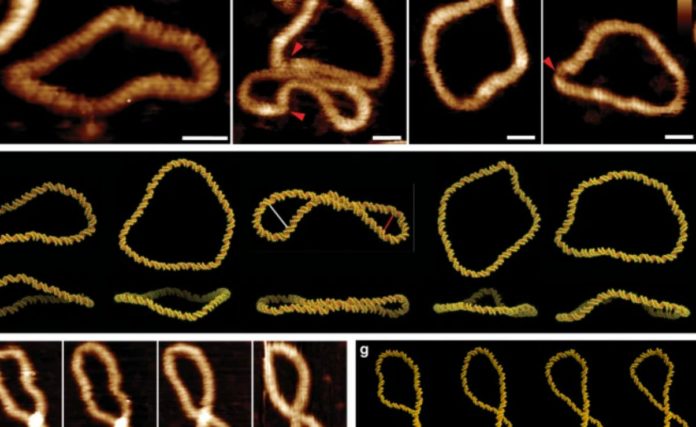Scientists from the UK have marked significant research in science by capturing the world’s highest-resolution images and videos of a dancing DNA showing how the DNA dances inside the cell.
Deoxyribose nucleic acid (DNA) is home to all the genetic information of any living organism, be it human beings, plants, or animals. These are double-helix molecules, meaning they contain two strands of nucleic acid. DNA provides the cells with instructions to produce proteins. The unique genetic code that is held by DNA enables it to determine the physical and cognitive characteristics of an individual.
- Neuroscience Breakthrough: Study Pinpoints Brain Activity That Helps Prevent Us From Getting Lost
- Brief Anger Hampers Blood Vessel Function Leading to Increased Risk of Heart Disease and Stroke – New Study
- New Blood Test Pinpoints Future Stroke Risk – Study Identifies Inflammatory Molecules as Key Biomarker
- Enceladus: A Potential Haven for Extraterrestrial Life in its Hidden Ocean Depths
- New Experiment: Dark Matter Is Not As ‘DARK’ As All We Think
In the latest research relating to this utmost crucial center of genetic information, the highest resolution videos capturing a dancing DNA have been captured and published in Nature Communications. The spectacular videos show the dance-like movements of the DNA inside a cell.
With the limitations in technology and manpower in the field of scientific research and development, capturing still images of DNA could not be worked out as much. Although the pictures then, have successfully captured the double-helix or double-stranded structure of DNA, the intriguing details of the day were missed.
However, with the technological advancements and the ever-stretching limits of research, the goal has finally been met by the researchers from Yorkshire. The unparalleled videos of the Dancing DNA were created by them using “advanced atomic force microscopy” with “powerful supercomputer simulations“. Also, in the latest research, videos have made every single atom of the molecule visible, and also the way it’s been swaying in there!



The rarest video was created with the help of images having the highest resolution of all times that were ever being used by scientists. The video makes an immensely detailed and microscopic representation of the way the shape of this long molecule can undergo a change when it is held inside the cell in a constrained manner.
DNA held inside a small cell could be 2 meters to 6.5 meters long. Therefore, it has to twist and curve in order to fit inside. When the DNA molecules merge at both ends they form DNA minicircles. The scientists also observed the minicircles making them twist even more. These movements that make it appear like a Dancing DNA have been recorded in the video.
While sharing her experience in capturing the video, Dr Alice Pyne, who is a scholar in polymer and soft matter at the University of Sheffield said: “seeing is believing, but with something as small as DNA, seeing the helical structure of the entire DNA molecule was extremely challenging.” She also added further that the videos ‘enable us to observe DNA twisting in a level of detail that has never been seen before.”
- Neuroscience Breakthrough: Study Pinpoints Brain Activity That Helps Prevent Us From Getting Lost
- Brief Anger Hampers Blood Vessel Function Leading to Increased Risk of Heart Disease and Stroke – New Study
- New Blood Test Pinpoints Future Stroke Risk – Study Identifies Inflammatory Molecules as Key Biomarker
- Enceladus: A Potential Haven for Extraterrestrial Life in its Hidden Ocean Depths
- New Experiment: Dark Matter Is Not As ‘DARK’ As All We Think
In order to compare the relaxed and twisted structures of DNA, they captured the images of both, and observed the loops.
Prof.Lynn Zechiedrich, an expert who played a significant role in studying the minicircles during the research said: “Dr Pyne and her co-worker’s new AFM structures of our supercoiled minicircles are extremely exciting because they show, with remarkable detail, how wrinkled, bubbled, kinked, denatured, and strangely shaped they are which we hope to be able to control someday.”
Dr Sarah Harris who monitored the research highlighted the importance of physics in studying DNA.
The earlier studies had suggested that the minicircle forms of DNA could be indicative of aging and marked an onset for other illnesses. The vast research about DNA can add new dimensions and discoveries in the field of medicine and genetics.
